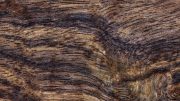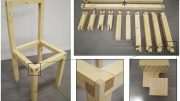The sharpest knives available are made of either steel or ceramic, both of which are man-made materials that must be forged in furnaces under extreme temperatures. Now, researchers have developed a potentially more sustainable way to make sharp knives: using hardened wood. The method, presented October 20th, 2021, in the journal Matter, makes wood 23 times harder, and a knife made from the material is nearly three times sharper than a stainless-steel dinner table knife.
“The knife cuts through a medium-well done steak easily, with similar performance to a dinner table knife,” says Teng Li, the senior author of the study and a materials scientist at the University of Maryland. Afterward, the hardened wood knife can be washed and reused, making it a promising alternative to steel, ceramic, and disposable plastic knives.
Li and his team also demonstrated that their material can be used to produce wooden nails as sharp as conventional steel nails. Unlike steel nails, the wooden nails the team developed are resistant to rusting. The researchers showed that these wooden nails could be used to hammer together three boards without any damage to the nail. In addition to knives and nails, Li hopes that, in the future, the material can also be used to make hardwood flooring that is more resistant to scratching and wear.
While Li’s method to produce hardened wood is new, wood processing in general has been around for centuries. However, when wood is prepared for furniture or building materials, it is only processed with steam and compression, and the material rebounds somewhat after shaping. “When you look around at the hard materials you use in your daily life, you see many of them are man-made materials because natural materials won’t necessarily satisfy what we need,” says Li.
“Cellulose, the main component of wood, has a higher ratio of strength to density than most engineered materials, like ceramics, metals, and polymers, but our existing usage of wood barely touches its full potential,” he says. Even though it’s often used in building, wood’s strength falls short of that of cellulose. This is because wood is made up of only 40%–50% cellulose, with the rest consisting of hemicellulose and lignin, which acts as a binder.
Li and his team sought to process wood in such a way to remove the weaker components while not destroying the cellulose skeleton. “It’s a two-step process,” says Li. “In the first step, we partially delignify wood. Typically, wood is very rigid, but after removal of the lignin, it becomes soft, flexible, and somewhat squishy. In the second step, we do a hot press by applying pressure and heat to the chemically processed wood to densify and remove the water.”
After the material is processed and carved into the desired shape, it is coated in mineral oil to extend its lifetime. Cellulose tends to absorb water, so this coating preserves the knife’s sharpness during use and when it is washed in the sink or dishwasher.
Using high-resolution microscopy, Li and his team examined the microstructure of the hardened wood to determine the origin of its strength. “The strength of a piece of material is very sensitive to the size and density of defects, like voids, channels, or pits,” says Li. “The two-step process we are using to process the natural wood significantly reduces or removes the defects in natural wood, so those channels to transport water or other nutrients in the tree are almost gone.”
This wood-hardening process has the potential to be more energy-efficient and have a lower environmental impact than for the manufacture of other man-made materials, although more in-depth analysis is necessary to say for sure. The first step requires boiling the wood at 100° Celsius in a bath of chemicals, which could potentially be reused from batch to batch. For comparison, the process used to make ceramics requires heating materials up to a few thousand degrees Celsius.
“In our kitchen, we have many wood pieces that we use for a very long time, like a cutting board, chopsticks, or a rolling pin,” says Li. “These knives, too, can be used many times if you resurface them, sharpen them, and perform the same regular upkeep.”
Reference: “Hardened wood as a renewable alternative to steel and plastic” by Bo Chen, Ulrich H. Leiste, William L. Fourney, Yu Liu, Qiongyu Chen and Teng Li, 20 October 2021, Matter.
DOI: 10.1016/j.matt.2021.09.020
This work was supported by Advanced Research Projects Agency – Energy.









The knife cut through fat, not meat. The nail was tapped slowly through pre-drilled holes.
Nomo Bo, where did you get that info? It’s not what the article says.
I agree, the article doesn’t explicitly state Nomo Bo’s claims and was about to post a similar response. However…
The video of the knife cutting through steak shows the knife cutting through fatty tissue. This video may or may not be of the actual cutting test but it was provided as an example of the knife at work. I submit that if the video provider meant to show the knife cutting through “..a medium-well done steak easily..”, it was a poor choice as a representation of the knife’s capabilities.
Regarding the claim regarding the nail..
First of all, the second video shows the wooden nail being inserted into what seems to be a pre-drilled hole in at least the first piece of wood. Watch the video carefully as the nail is positioned; it actually drops down into the piece of wood before hammering begins. The fact the video does -not- show the wood surface that is receiving the nail point does lead to some doubt.
Secondly, all three pieces of wood have on the sides facing the camera what appears to be an “alignment marking”. Such markings are not necessary to align the wood pieces horizontally but are sometimes, but not always, necessary to help line up pre-drilled “pilot” holes. (Personal note: I’ve done carpentry in the past and have used such a method to connect small pieces of wood using wooden dowels.)
Third, the speed at which the nail is lightly tapped through the wood also implies the use of pilot holes. A steel nail would actually cut its own way through each piece of wood and would actually require much stronger impacts to do so (again, my personal experience with carpentry).
Perhaps a better demonstration of the new nail’s sharpness of “..conventional steel nails..” would be a video of it be used on a wooden fence with the surface of the wood the nail is going through facing the camera rather than being shown as a side view.